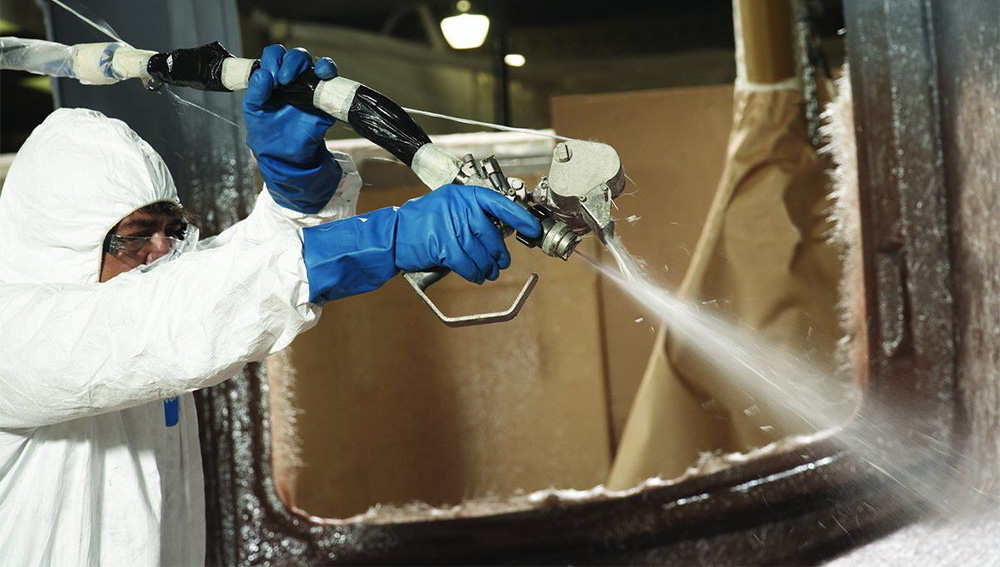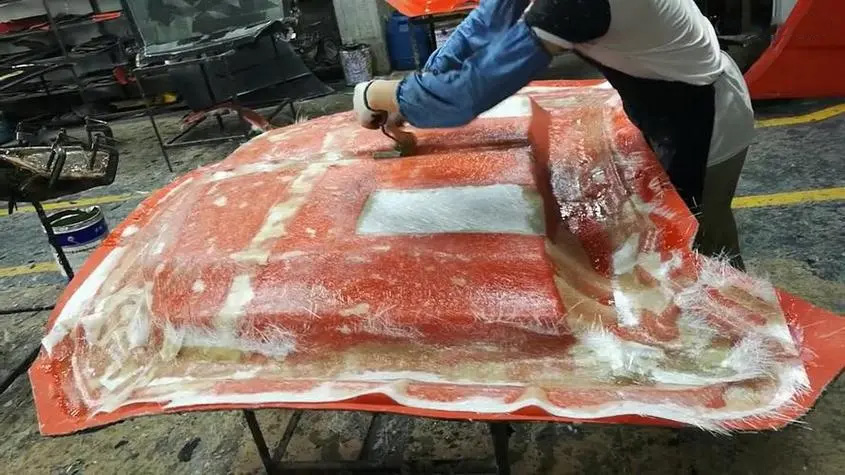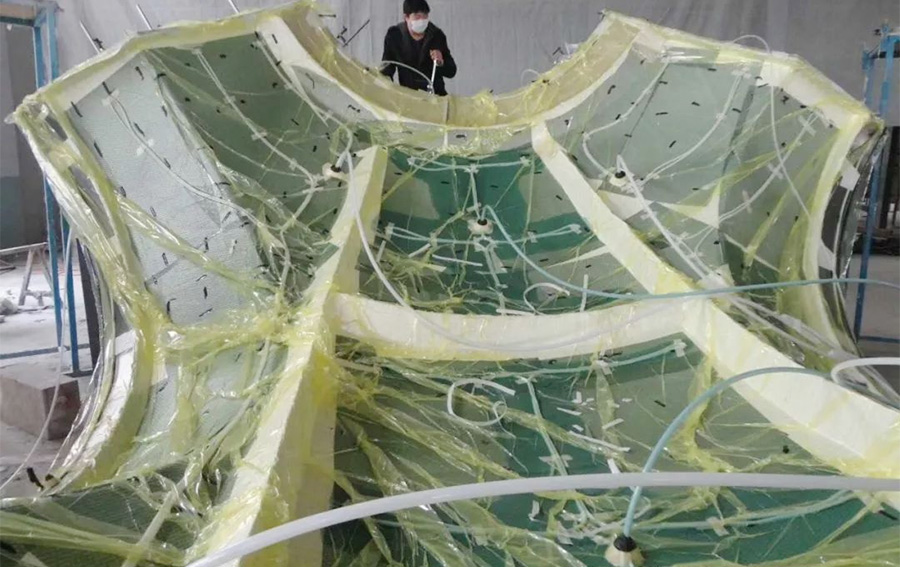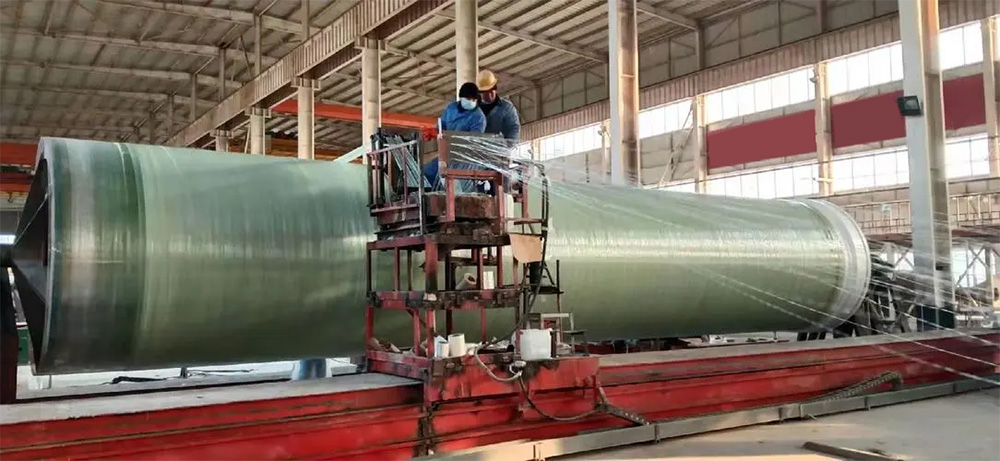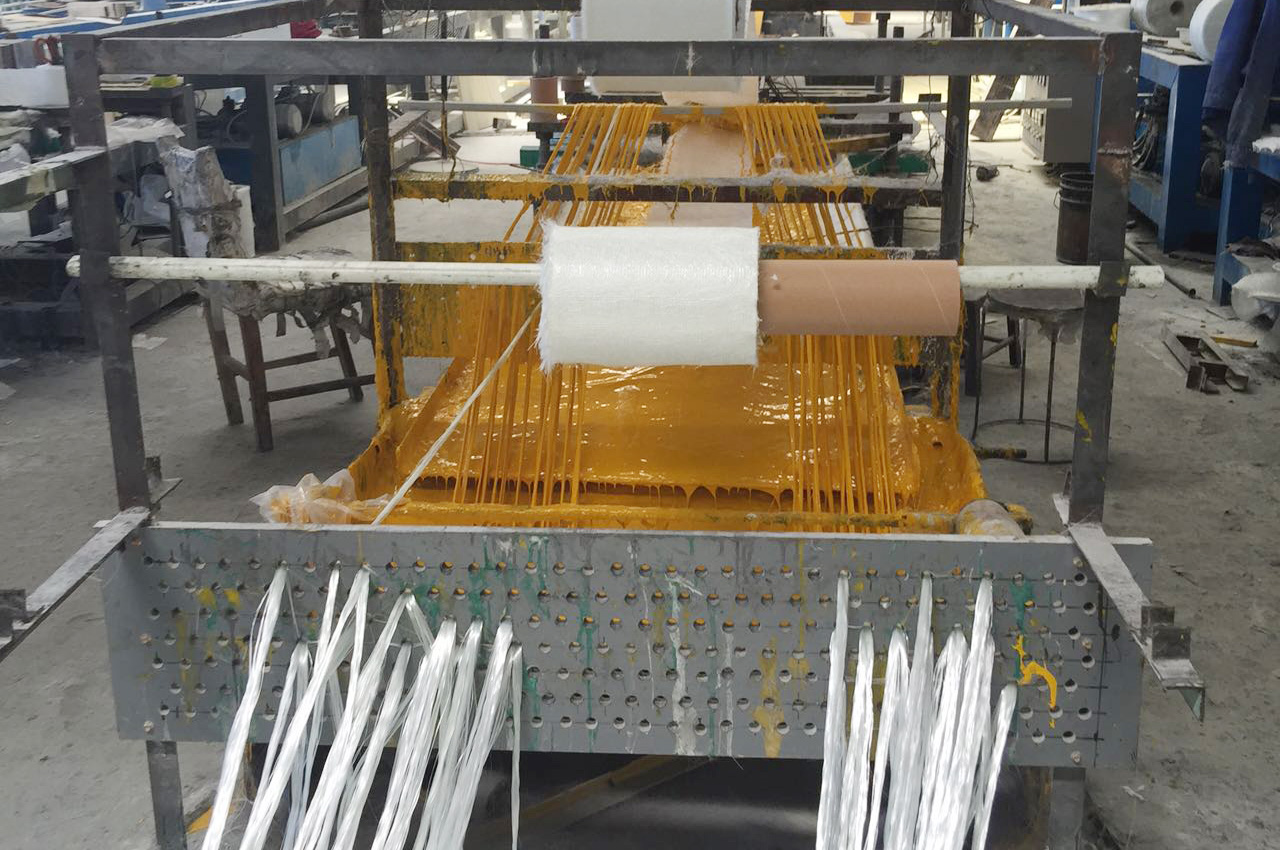There is a wide choice of raw materials for composites, including resins, fibers, and core materials, and each material has its own unique properties of strength, stiffness, toughness, and thermal stability, with varying costs and yields. However, the final performance of a composite material as a whole is not only related to the resin matrix and fibers (as well as the core material in a sandwich material structure), but also closely related to the design method and manufacturing process of the materials in the structure. In this paper, we will introduce the commonly used manufacturing methods for composites, the main influencing factors of each method and how raw materials are selected for different processes.
Spray molding
1, method description: the short-cut fiber reinforcing material and resin system at the same time sprayed in the mold, and then cured under atmospheric pressure into thermosetting composite products of a molding process.
2. Material selection:
Resin: mainly polyester
Fiber: coarse glass fiber yarn
Core material: none, need to be combined with plywood alone
3. Main advantages:
1) Long history of craftsmanship
2) Low cost, fast lay-up of fiber and resin
3) Low mold cost
4, the main disadvantages:
1) The plywood is easy to form resin-rich area, high weight
2) Only short-cut fibers can be used, which seriously limits the mechanical properties of plywood.
3) In order to facilitate spraying, the resin viscosity needs to be low enough, losing the mechanical and thermal properties of the composite material.
4) The high styrene content of the spray resin means that there is a high potential hazard to the operator, and the low viscosity means that the resin can easily penetrate the employee’s work clothes and come into direct contact with the skin.
5) The concentration of volatile styrene in the air is difficult to meet legal requirements.
5. Typical Applications:
Simple fencing, low load structural panels such as convertible car bodies, truck fairings, bathtubs and small boats.
Hand Layup Molding
1, method description: manually infiltrate the resin into the fibers, the fibers can be woven, braided, sewn or bonded and other reinforcing methods, hand lay-up molding is usually done with rollers or brushes, and then the resin is squeezed with a glue roller to make it penetrate into the fibers. The plywood is placed under normal pressure to cure.
2. Material selection:
Resin: no requirement, epoxy, polyester, polyethylene-based ester, phenolic resins are available
Fiber: no requirements, but the base weight of the larger aramid fiber is difficult to infiltrate the hand-laid
Core material: no requirement
3, the main advantages:
1) Long history of technology
2) Easy to learn
3) low mold cost if using room temperature curing resin
4) Wide choice of materials and suppliers
5) High fiber content, longer fibers used than spraying process
4, Main disadvantages:
1) Resin mixing, laminate resin content and quality are closely related to the operator’s proficiency, it is difficult to obtain low resin content and low porosity of the laminate
2) Resin health and safety hazards, the lower the molecular weight of the hand lay-up resin, the greater the potential health threat, the lower the viscosity means that the resin is more likely to penetrate the employees’ work clothes and thus come into direct contact with the skin.
3) If good ventilation is not installed, the concentration of styrene evaporated from polyester and polyethylene-based esters into the air is difficult to meet legal requirements
4) The viscosity of the hand-paste resin needs to be very low, so the content of styrene or other solvents must be high, thus losing the mechanical/thermal properties of the composite material.
5) Typical applications: standard wind turbine blades, mass produced boats, architectural models.
Vacuum bagging process
1. Method description: Vacuum bagging process is an extension of the above hand-layup process, i.e. sealing a layer of plastic film on the mold will be hand-layup plywood vacuum, applying an atmospheric pressure to the plywood to achieve the effect of exhausting and tightening, in order to improve the quality of the composite material.
2. material selection:
Resin: mainly epoxy and phenolic resins, polyester and polyethylene-based ester is not applicable, because they contain styrene, volatilization into the vacuum pump
Fiber: no requirement, even if the base weight of the larger fibers can be infiltrated under pressure
Core material: no requirement
3. Main advantages:
1) Higher fiber content than standard hand lay-up process can be achieved
2) The void ratio is lower than the standard hand lay-up process.
3) Under negative pressure, the resin flows sufficiently to improve the degree of fiber infiltration, of course, part of the resin will be absorbed by the vacuum consumables
4) Health and safety: vacuum bagging process can reduce the release of volatiles during the curing process
4, Main disadvantages:
1) Additional process increases the cost of labor and disposable vacuum bag material
2) Higher skill requirements for operators
3) Resin mixing and control of resin content depends largely on operator proficiency
4) Although vacuum bags reduce the release of volatiles, the health risk to the operator is still higher than that of the infusion or prepreg process
5, Typical applications: large size, single limited edition yachts, racing car parts, shipbuilding process of the core material bonding.
Winding Molding
1. Description of the method: The winding process is basically used to manufacture hollow, round or oval shaped structural parts such as pipes and troughs. Fiber bundles are resin-impregnated and then wound on a mandrel in various directions. The process is controlled by the winding machine and the mandrel speed.
2. Material selection:
Resin: no requirement, such as epoxy, polyester, polyethylene-based ester and phenolic resin, etc.
Fiber: no requirements, direct use of fiber bundles of the spool frame, do not need to weave or sewing woven into the fiber cloth
Core material: no requirement, but the skin is usually a single-layer composite material
3. the main advantages:
(1) fast production speed, is an economic and reasonable way of layups
(2) Resin content can be controlled by measuring the amount of resin carried by fiber bundles passing through the resin groove.
(3) Minimized fiber cost, no intermediate weaving process
(4) excellent structural performance, because the linear fiber bundles can be laid along the various load bearing directions
4. Main disadvantages:
(1) The process is limited to round hollow structures.
(2) Fibers are not easily and accurately arranged along the axial direction of the component
(3) Higher cost of mandrel positive molding for large structural parts
(4) The outer surface of the structure is not a mold surface, so the aesthetics is worse
(5) The use of low-viscosity resin, need to pay attention to mechanical properties and health and safety performance
Typical applications: chemical storage tanks and pipes, cylinders, fire-fighter breathing tanks.
Pultrusion molding
1. method description: from the bobbin holder drawn fiber bundle impregnated with glue through the heating plate, in the heating plate to complete the resin on the fiber infiltration, and control the resin content, and ultimately the material will be cured into the required shape; this shape of the fixed cured product is mechanically cut into different lengths. Fibers can also enter the hot plate in directions other than 0 degrees. Extrusion and stretch molding is a continuous production process and the product cross-section usually has a fixed shape, allowing for slight variations. Will pass through the hot plate of the pre-wetted material fixed and spread into the mold immediately curing, although such a process is less continuous, but can achieve the cross-section shape change.
2. Material selection:
Resin: usually epoxy, polyester, polyethylene-based ester and phenolic resin, etc.
Fiber: no requirement
Core material: not commonly used
3. Main advantages:
(1) fast production speed, is an economical and reasonable way of pre-wetting and curing materials
(2) precise control of resin content
(3) fiber cost minimization, no intermediate weaving process
(4) excellent structural properties, because the fiber bundles are arranged in straight lines, fiber volume fraction is high
(5) fiber infiltration area can be completely sealed to reduce the release of volatiles
4. the main disadvantages:
(1) the process limits the shape of the cross-section
(2) Higher cost of heating plate
5. Typical applications: beams and trusses of housing structures, bridges, ladders and fences.
Resin Transfer Molding Process (RTM)
1. Description of the method: Dry fibers are laid in the lower mold, which can be pre-pressurized to make the fibers fit the shape of the mold as much as possible and be adhesively bound; then, the upper mold is fixed on the lower mold to form a cavity, and then the resin is injected into the cavity. Vacuum-assisted resin injection and infiltration of the fibers, known as Vacuum-Assisted Resin Injection (VARI), is commonly used. Once the fiber infiltration is complete, the resin introduction valve is closed and the composite is cured. Resin injection and curing can be done either at room temperature or under heated conditions.
2. Material Selection:
Resin: usually epoxy, polyester, polyvinyl ester and phenolic resin, bismaleimide resin can be used at high temperature
Fiber: no requirement. Sewn fiber is more suitable for this process, because the gap between the fiber bundle is conducive to resin transfer; there are specially developed fibers can promote resin flow
Core material: cellular foam is not suitable, because the honeycomb cells will be filled with resin, and the pressure will also cause the foam to collapse.
3. the main advantages:
(1) Higher fiber volume fraction, low porosity
(2) Health and safety, clean and tidy operation environment as the resin is completely sealed.
(3) Reduce the use of labor
(4) The upper and lower sides of the structural parts are molded surfaces, which is easy for subsequent surface treatment.
4. Main disadvantages:
(1) The molds used together are expensive, heavy and relatively bulky in order to withstand greater pressure.
(2) limited to the manufacture of small parts
(3) Unwetted areas can easily occur, resulting in a large number of scrap
5. Typical applications: small and complex space shuttle and automobile parts, train seats.
Post time: Aug-08-2024


